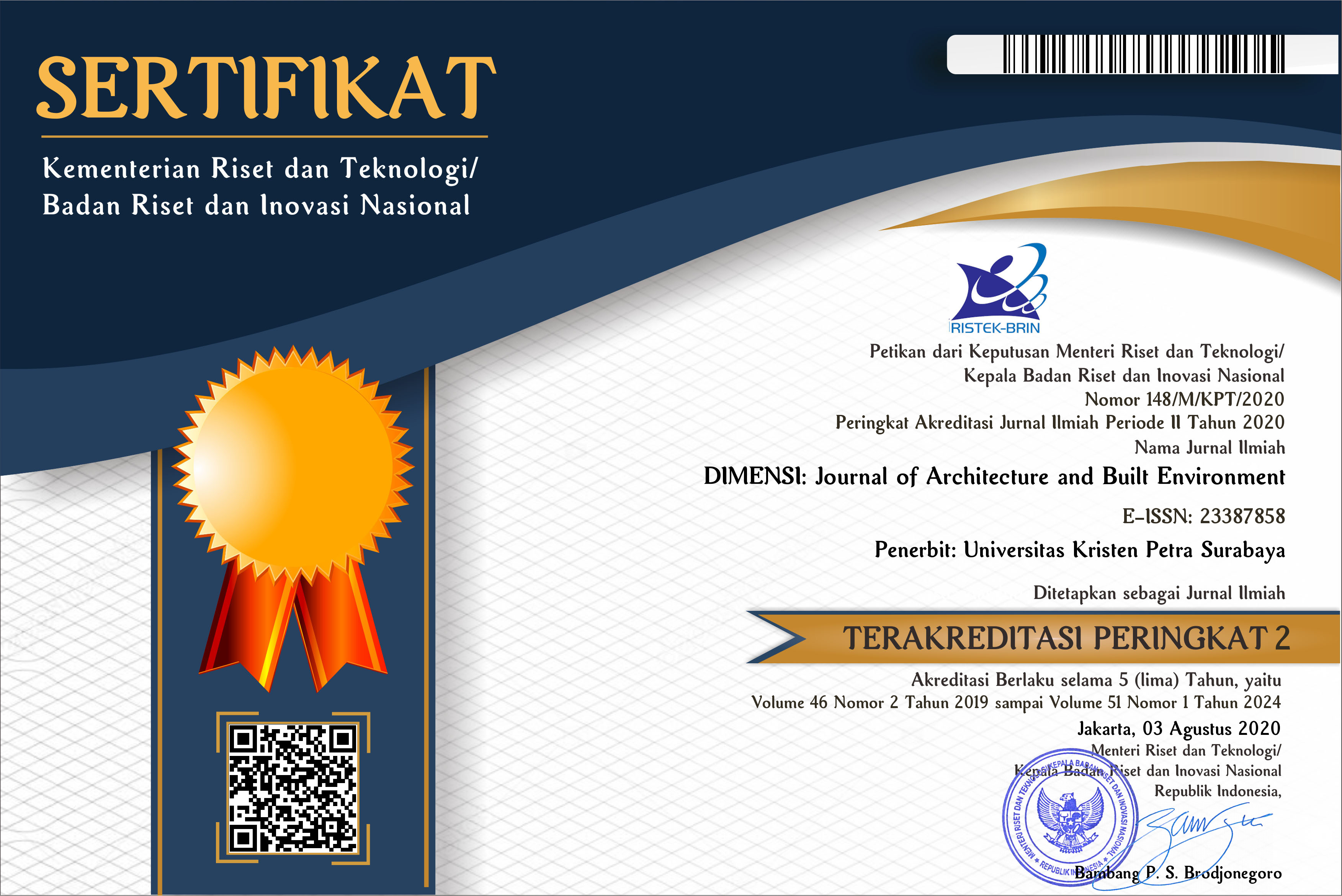CARBON FOOTPRINT ANALYSIS OF A T-45 HOUSE IN KUPANG
 :
:
https://doi.org/10.9744/dimensi.43.2.77-84
Keywords:
Carbon footprint, climate change, detailed calculation, remote location, T-45 housing.Abstract
Carbon dioxide (CO2 and CO2e) concentration in the atmosphere steadily increases and, in some places, has passed 360ppm, which is the limiting point agreed by world leaders to slow down and stop global warming. Housing sectors have been claimed to emit significant amounts of CO2. This paper reports a research on the carbon footprint of a T-45 house in Kupang. The research calculated in detail the carbon emission of the house since its pre-construction stage (design process), construction stage, to the post-construction stage (house operation from year one to year 25). The T-45 house was selected as this type is the smallest standard house for a family of three in Indonesia. Literature, survey and analytical methods were adopted. The research found that the longer the house was used, the lower the carbon emission borne by each occupant per year. From year one to year 25, the total carbon emission borne by each occupant decreased from 3,590,793.44 to 145,568.38 kgCO2 per year. The construction stage emits a considerable amount of CO2 so that its carbon footprint still dominates the proportion of carbon emission per year per occupant, 98.61%. In the construction stage, use of cement in the wall and concrete structure works contributes the largest proportion of carbon emission, 96.7%. Therefore, using locally available construction materials, in particular, natural ones with less or zero carbon emission, is highly recommended.Downloads
References
BAPPEDA. (2009). Revisi RTRW Kota Kupang, Badan Perencanaan Pembangunan Daerah Kota Kupang, Kupang.[CrossRef]
BPKIMI. (2012). Draft Petunjuk Teknis Perhitungan Emisi Gas Rumah Kaca di Sektor Industri, Badan Pengkajian Kebijakan Iklim dan Mutu Industri, Jakarta. [CrossRef]
BPS. (2015). Kota Kupang Dalam Angka 2014, Badan Pusat Statistik Kota Kupang, Kupang. [CrossRef]
C2ES. (2015). Outcomes of the U.N. Climate Change Conference in Paris, Center for Climate and Energy Solutions, Paris. [CrossRef]
CECCIAQPH. (2011). Climate Change, the Indoor Environment, and Health, Committee on the Effect of Climate Change on Indoor Air Quality and Public Health, The National Academies Press, Washington, D.C. [CrossRef]
Davis, L.W., Gertler, P.J. (2015). Contribution of Air Conditioning Adoption to Future Energy Use under Global Warming, Proceedings of the National Academy of Sciences, 112(19), p. 5962-5967. [CrossRef]
Frick, H., Suskiyatno, F.B. (2007). Dasar-dasar Arsi-tektur Ekologis: Konsep Pembangunan Berkelanjutan dan Ramah Lingkungan, Seri Eko-Arsitektur 1, Kanisius, Yogyakarta. [CrossRef]
Hansen, J. et al. (2013). Assessing “Dangerous Climate Change”: Required Reduction of Carbon Emissions to Protect Young People, Future Generations and Nature. Plos one.
http://dx.doi.org/10.1371/journal.pone.0081648.[CrossRef]
http://www.esrl.noaa.gov/; accessed Nov 1, 2016.[CrossRef]
http://www. worldbank.org/; accessed Nov 1, 2016.[CrossRef]
IPCC. (2006). General Guidance and Reporting, Volume 1. Intergovernmental Panel on Climate Change, Geneve.[CrossRef]
MPPWRI. (2002). Keputusan Menteri Permukiman dan Prasarana Wilayah Republik Indonesia, Nomor: 403/KPTS/M/2002 Tentang Pedoman Teknis Pembangunan Rumah Sederhana Sehat(Rs Sehat), Menteri Permukiman dan Prasarana Wilayah Republik Indonesia, Jakarta.[CrossRef]
Schreuder, Y. (2009). The Corporate Greenhouse: Climate Change Policy in a Globalizing World, Zed Books, London.[CrossRef]
UNEP. (2009). Buildings and Climate Change, United Nations Environment Programme, Milan.[CrossRef]
Wiedmann, T., Minx, J. (2007). A Definition of 'Carbon Footprint', ISA UK Research Report 07-01.[CrossRef]
Downloads
Published
How to Cite
Issue
Section
License
Authors who publish with this journal agree to the following terms:
- Authors retain copyright and grant the journal right of first publication with the work simultaneously licensed under a Creative Commons Attribution License that allows others to share the work with an acknowledgement of the work's authorship and initial publication in this journal.
- Authors are able to enter into separate, additional contractual arrangements for the non-exclusive distribution of the journal's published version of the work (e.g., post it to an institutional repository or publish it in a book), with an acknowledgement of its initial publication in this journal.
- Authors are permitted and encouraged to post their work online (e.g., in institutional repositories or on their website) prior to and during the submission process, as it can lead to productive exchanges, as well as earlier and greater citation of published work (See The Effect of Open Access).


















